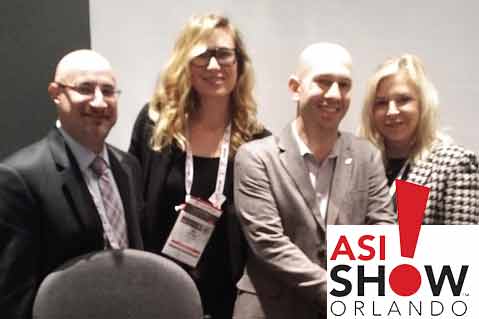News January 19, 2017
Incentive Experts Share Strategies for Success
In a packed session at ASI Orlando, Andy Cohen, ASI’s vice president of Editorial & Creative Services, led a lively panel discussion on the topic of Incentive Success Stories: Distributors Share Their Secrets.

Cohen’s panelists – Jill Albers, vice president of business development for Dayton, OH-based Shumsky (asi/326300); Danny Braunstein, vice president of business development for London, Ontario-based distributor Talbot Marketing (asi/341500); and Sharon Biernat, account executive for Chicago-based Creative Promos (asi/170669) – each talked about the many pros (and a few cons) of selling incentive-based programs.
“First of all, because you’re typically working with HR departments to set up these programs, they really need to have their ducks in a row to make sure the programs are set up legally and correctly, regarding who’s responsible for taxes on the incentive gift items – which can be quite pricey – the company or the recipient,” Biernat said.
Albers, who handles over 30 incentive programs – one for most of her clients – pointed out that it’s important to remember an incentive program represents the internal brand of an organization.
“When pitching an incentive program to clients, just remember that the external and internal brand of the company have to align,” she said.
All three panelists agreed that areas ripe for incentive programs are HR initiatives – finding, keeping and rewarding employees – safety programs and co-op programs. “Especially with HR-driven programs, you really need to pay attention to KPI – key performance indicators – and ask your client what their specific goals and motivators are,” Albers said. “Listen, I'm probably the most in-person millennial on the planet – I just get on a plane and go to be part of a client meeting where they’re discussing incentive initiatives – being there in person makes all the difference.”
Braunstein noted that in his experience crafting incentive programs, it’s more critical than ever to be a solutions provider and to focus more on the clients’ needs by asking thorough questions and really listening to the answers. “The benefit of that, of course, is that the more embedded you are with the client, the more of a competitive advantage you have to keep them from buying from other promo companies who don’t have a history with them.”
Albers also pointed out that you should really take on the role of a consultant when selling incentives, and that oftentimes clients aren’t aware that they can get tax breaks, insurance rebates and lower workman’s comp rates when they utilize incentives. Sean Roark, a distributor in the audience with an expertise in selling incentives, suggested that those who want to learn more go to the IRS website and search info on document 274J.
And while Braunstein, Albers and Biernat all cautioned that selling and maintaining an incentive campaign isn’t a quick sale and often requires more time and patience than selling a pen order, the payoff can be lucrative. “I have one client who was doing about $6,000 with me and now, because of their robust incentive programs, does over $100,000,” Braunstein said, adding, “but you can’t fake it – you really have to become knowledgeable about incentives so you know what you’re talking about.”
